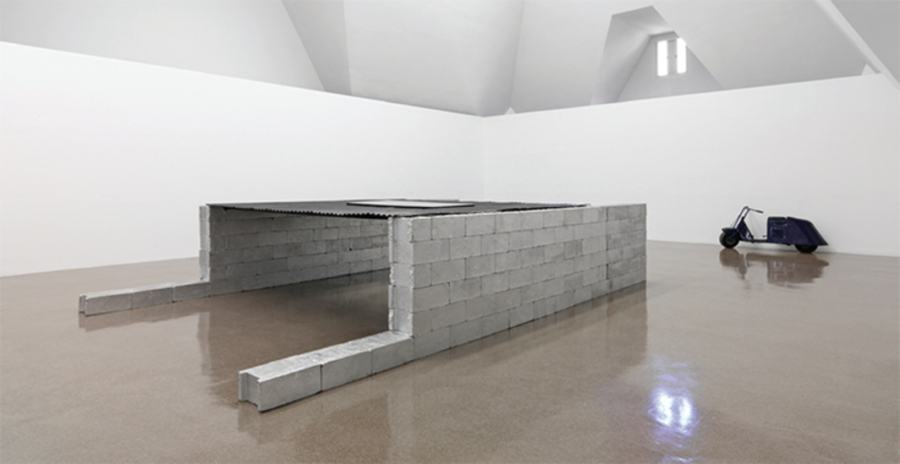Summer 2017
Download as PDF
View on Artforum

View of “Robert Grosvenor,” 2017. From left: Untitled, 1989–90; untitled adjunct. Photo: Tom Van Eynde.
In a gutsy move for both artist and institution, Robert Grosvenor’s first museum exhibition in more than a decade consisted of a single work—and one created almost thirty years ago. Entering the exhibition space through a small vestibule, one immediately came face-to-face with Untitled, 1989–90, an enigmatic construction sitting, sphinxlike, in the Renaissance Society’s dramatically vaulted gallery. Two parallel walls of silver-painted cinder blocks, each six units high, were positioned directly on the gallery’s mottled gray linoleum floor. Extending from the leftward end of each wall was a single row of three similarly painted blocks laid end-to-end, their interior cavities filled with cement. A large sheet of weathered corrugated steel rested atop the walls, spanning the approximately twelve feet between them. A rectangular opening in the makeshift roof was covered by a piece of Plexiglas, raised slightly from the corrugation by the metal frame on which it sat, giving it the appearance of a skylight; and indeed, light from above shone through it onto the floor below. As one moved slowly around the sculpture, subtle variations in surface quality and masonry gave clues to the work’s facture but stubbornly refused to offer anything resembling a motive.
Located on the neo-Gothic central quadrangle of the University of Chicago, the Renaissance Society’s gallery is notable for the turreted alcoves in each of its four corners, its abundance of windows, and its soaring thirty-foot ceiling. In consultation with the society’s director, Solveig Øvstebø, who curated the exhibition, Grosvenor arranged for a twelve-foot-high perimeter wall to be erected in front of three gallery walls, transforming the symmetrical but highly irregular contours of the space into a slightly off-center rectangle. Beyond obscuring the room’s turrets and low windows and redirecting attention to the sculpture itself, the perimeter wall produced two simultaneous but seemingly oppositional effects. On the one hand, it accentuated the gallery’s cathedral-like verticality. On the other, it additionally imposed on the space a strong sense of horizontality—a horizon, even—a central and abiding concern for the artist since he first came to prominence in the 1960s, and one that is also reflected in the low-slung quality of Untitled.
Grosvenor’s most powerful works have always emphasized a productive tension between artwork, viewer, and the architectural space they both occupy. At the Renaissance Society, Grosvenor added a fourth element to this equation. Off to one side of the sculpture, leaning against the gallery’s east wall, an antique motor scooter (a Cushman model dating from the late 1940s) perhaps added a narrative dimension to the installation. Painted a deep-blue hue, the vehicle was—importantly—not part of the sculpture but rather, in the artist’s words, an “adjunct” to the work. Nevertheless, its copresence in the gallery complicated what might otherwise have been a stable triad, not least by implicating Untitled in an economy of functionality and use that Grosvenor has historically taken great pains to avoid.
The scooter also stood in a contrapuntal formal relation with Untitled, its own coloration bringing out passages of blue enamel on the sculpture’s corrugated steel “roof” that might otherwise have escaped notice, thereby highlighting the chromatic play between the muted but variegated surface of the weathered steel and the cinder blocks’ highly reflective but uniform coating. Similarly, the Cushman’s curvilinear yet boxy profile somehow called attention to a subtle formal dynamic between Untitled’s undulating canopy and the rectilinear walls that supported it.
Although Grosvenor has long employed everyday building materials, he has always denied his works’ resemblance to architecture. “I didn’t ever think of them as shelters,” he has stated, adding that in the case of Untitled, “the rooflike element protects an area of negative space which is part of the sculpture.” Appended twenty-seven years after Untitled was originally created, the “adjunct” somehow both buttressed this position (the scooter’s obvious functionality contrasting with the sculpture’s lack thereof) and rebutted it: If not a shelter for people, what about for small vehicles? Almost four decades after Rosalind Krauss published “Sculpture in the Expanded Field,” her influential 1979 analysis of both the specificity and mutual imbrication of contemporary sculpture, architecture, and landscape, Untitled reminds us that the boundaries between these realms remain far from fixed.
—Jacob Proctor



